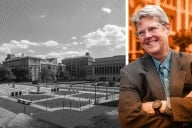You have /5 articles left.
Sign up for a free account or log in.
Joan Lorden said she noticed something unsettling a few years ago: When she went to events honoring professors for teaching awards, there was too much overlap in those being honored with those whose retirements were being announced at the University of North Carolina at Charlotte, where she is provost. She worried about losing "the backbone of departments," she said.
At the same time, she said she hears from counterparts at other institutions about the opposite problem: They want to build new programs and can't adjust faculty lines to reflect those priorities because some people they would like to retire show no intention of packing up.
Lorden and other provosts attending the annual meeting of the National Association of State Universities and Land-Grant Colleges on Monday reviewed some of the research on what issues affect professors' choice. While there was much talk about "managing" the process of faculty retirement, an undercurrent of the discussion was that there is only so much managing institutions can do with tenured professors approaching traditional retirement age. If they are doing their jobs well, age discrimination laws (which colleges must follow, despite a previous and now long expired exemption for faculty jobs) give the power to faculty members. As a result, the provosts and other administrators are keenly interested in professors' retirement concerns and their interest in programs to phase in retirement.
Paul J. Yakoboski, principal research fellow with the TIAA-CREF Institute, presented data from his recent study of faculty job satisfaction, which found that large percentages of faculty members are open to programs that phase in retirement. At the same time, he noted that faculty members are sharp observers of what their institutions are doing -- and that can work against institutions trying to plan. For instance, he said that the trend is that financial incentives to retire early appear to be rising over time, which may cause some professors to decide that "if I wait, I'll do better."
And even when faculty members accept early retirement options, they may not follow expected behaviors. One academic administrator in the audience said that his institution adopted a phased-in retirement program based on the assumption that faculty members would gradually ease out of their duties over a period of years. More than three-fourths of professors who signed up for the program actually went to full retirement within one year, surprising those who planned the effort, he said.
The retirement issues also have a huge impact on the career options open to young professors. A perfect illustration of this point came from Betsy E. Brown, special assistant to the provost of North Carolina State University, who presented data she gathered from two University of North Carolina System surveys of faculty members aged 50 and over, and related studies of that group. In 1982, about 35 percent of the system's tenure-track faculty members were under the age of 40 and less than 20 percent were over 55. Twenty years later, the percentages were flipped.
The North Carolina survey found that for faculty members over 50, the mean planned retirement age was 66. But in a sign that as professors approach retirement age, they may delay, the mean for faculty members 60 and older was 68. Faculty members estimated that they would need about 76 percent of their pre-retirement income to afford retirement. One finding that Brown said was "troubling" was that 24 percent of those surveyed didn't know what income level they would need for retirement.
The top reason cited to possibly retire early was having sufficient income. But the next three reasons cited -- feeling "burned out," dissatisfaction with work environment, and not performing the job to the professor's satisfaction -- all make up what Brown termed "self monitoring" by professors on when they should retire. Reasons cited not to retire early were high job satisfaction, financial concerns, rising health care costs, and anxieties about the state of the economy. Brown drew the audience's attention to the general economic concerns and noted that that may be increasing as a factor.
The North Carolina survey of phased-in retirement programs found a high degree of satisfaction by those who participated. Asked if they would make the same decision again if they could go back, 93 percent said they would participate. North Carolina started an option for phased-in retirement at the same time it instituted post-tenure review, and Brown noted the speculation that post-tenure review would be used to encourage retirements. In a survye of participants, however, only 1 percent cited post-tenure review as motivating their decision.
Doris R. Helms, provost of Clemson University, described retirement programs at her university. One was designed to create five-year paths toward retirement to allow for university planning. Others were designed primarily to deal with budget cuts. When done strategically, Helms said that retirement plans can have a huge benefit for an institution.
She described the discussions she had with departments where someone was on a set schedule to retirement, and asking "are you going to hire the exact same kind of person to teach the same courses or are you going to change the curriculum?" The phase-in period worked not only for the retirees, but for Clemson, Helms said, encouraging a kind of planning that doesn't always accompany a sudden resignation or retirement.
At the same time, there were some problems, Helms said. Some faculty members in the five-year program "stopped working," and she had people saying "I'm not taking on any more graduate students since I won't be here in three years." And, of course, she had the opposite problem, too: Some professors didn't want to retire at the end of five years.




